Stealth vs stealth
One is making Metal Gear Solid 5, another Volume. Both discuss the current state of stealth.
Jordan Amaro is a designer at Kojima Productions working on Metal Gear Solid 5: The Phantom Pain. Mike Bithell is a designer working at home on Volume. Both are making stealth games, but both are taking radically different approaches.
Where Amaro is helping to create a systemic, open-world stealth game starring one of the most famous video game characters of all time, Bithell is the one-man band behind a linear, old-school stealth game that rekindles memories of Solid Snake's first adventure on PSone.
How has the stealth genre changed over the years? With the likes of Splinter Cell and Hitman going down a more action-orientated route, some fans of old-school sneaking have become disillusioned with the genre. But has stealth in fact changed for the better? Here, in a joint interview with Eurogamer, the pair discuss the current state of the stealth genre, dissect the design process of both Metal Gear Solid and Volume, and ask why accessible stealth is such a dirty term.
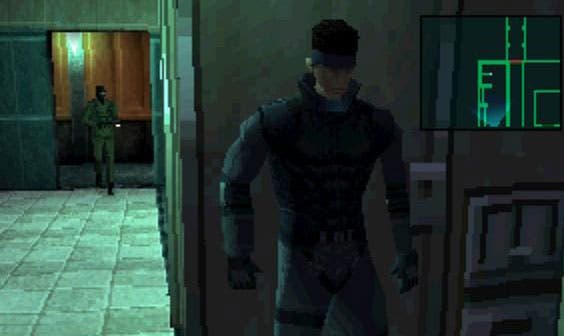
Eurogamer: What is your definition of stealth?
Mike Bithell: Hmm. It's really hard! Stealth is when you play a game and the outcome of your success, whether you win or you lose, is to do with your tactical choices, your evasion, your intelligent play through the level, and less to do with your ability to kill people. It's less to do with your ability to mow down baddies. It's less reflex-ey. It's more of a puzzle-solving thing. To me stealth games are puzzle games disguised as action games.
Jordan Amaro: When I play stealth games I feel like I'm voluntarily restricting my character's powers. I'm hampering primitive urges and expressing my humanity through the game. I always have the means to kill but I don't do it. It's self-inflicted difficulty. You could be done with the section in 30 seconds, but you sneak. You wait. You do diversions and spare lives. Being a stealth player is being beautiful.
Eurogamer: What makes for a good stealth game?
Mike Bithell: More than many genres, it comes down to control. All the ones I've loved have been about precision, have been about me coming up with a solution to a problem, and then nothing in the game getting in the way of me doing that, except a lack of forethought. If I fail I want it to be because of me. That's true of a lot of games but with stealth games in particular, that's what it's come down to. That feeling of precision. That precision of certainty of outcome if I just do things right and if I've thought everything through.
It goes back to that skills stuff and the intellectual side of the stealth game experience. I have to believe if I can perfectly understand the situation and perfectly plan out what's going on, nothing can go wrong. I want to feel like an expert. I want to be Leon. I want to be the perfect guy who makes this plan come to fruition.
"The fact you can't lose a sword fight in Assassin's Creed ever isn't interesting to me, because that's not my wish fulfilment."
Volume creator Mike Bithell
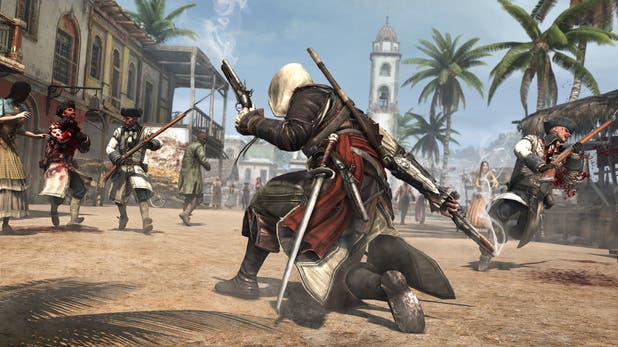
Eurogamer: What do you think makes for a good stealth game, Jordan?
Jordan Amaro: I like to feel the space, scripts and systems that have been laid out before me have not been engineered for me, the player. It's difficult to explain. You play some games and all the patterns are so obvious. You play the first levels of The Last of Us, and for the sake of tutorials the human enemies stare at brick walls, waiting for you to take them down. In Assassin's Creed you have the bushes laid out strangely and assets assembled weirdly. Or patrols in Deus Ex: Human Revolution that are super short and stop right before the corners for some reason... and those vents. Those practices destroy the entire credibility of the scene, the stage, and it pulls me out of the game since I'm shown the patterns. In other words, the aesthetics have effectively yielded before the mechanics and the game world has transgressed itself to reach the player, instead of staying true to itself.
Mike Bithell: I wonder if that's simply because you've got the game design brain. I'm a massive Assassin's Creed fan, and I must admit I really like the what the ridiculous amounts of foliage do in the new one. It makes me feel much more badass than I've ever felt in an Assassin's Creed game. It's that stealth badassery. The fact you can't lose a sword fight in Assassin's Creed ever isn't interesting to me, because that's not my wish fulfilment.
Jordan Amaro: Doesn't it insult your intelligence? You know, your right to improvise and experiment?
Mike Bithell: It does, but crucially for me it allows me to role-play being that clever. That's the interesting thing about Assassin's Creed. Hitman does it in places as well. In the same way as I'm not an excellent marksman, but I love feeling like I'm the baddest guy in the world with a gun, I like role-playing as the clever guy, with that super spy knowledge that none of us have in the real world. If we were in that situation we'd be dead very quickly.
But you're right. It's a balancing act. You don't want people to become aware of it. It's like auto-aim. If auto-aim is really obvious in a game, people feel like, well, I'm not really playing this. I don't have that agency. But a little bit of auto-aim makes you feel really good in Halo all the time. Getting that right, it's a line.
Now for you, that mechanic is too far. For me, it's too far if I'm playing in designer mode. But if I'm playing as a gamer, running around, being that guy, I kind of enjoy it. But I know what you mean though. It's a weird one.
Jordan Amaro: It's really strange. In the AC series there's that branch positioned right above the two guys and you know you can take them both down at once because you've done the same thing dozens of time with the same setup: a branch overlooking two guys.
We don't do that on MGS5. We don't use presets of objects, like that cart to that lattice to that gutter. We assemble assets together in an organic way so if you think you can get on the rooftop, you should be able to get there, not because the world is populated with assets you've been accustomed to identify.
On the developer's side, it takes a lot more time to make obviously, because it's an old-fashioned hand-crafted process, but the experience is radically different. When you are in our environments, you need to observe, use your binoculars, mark the guys and say, okay, what do I do now? There's no obvious road.
"There is a fundamental difference between many western games and the way we do things on Metal Gear, and that's partly due to the fact that MGS5 is KJP's first open-world game and we're discovering what that means while making it."
Kojima Productions designer Jordan Amaro
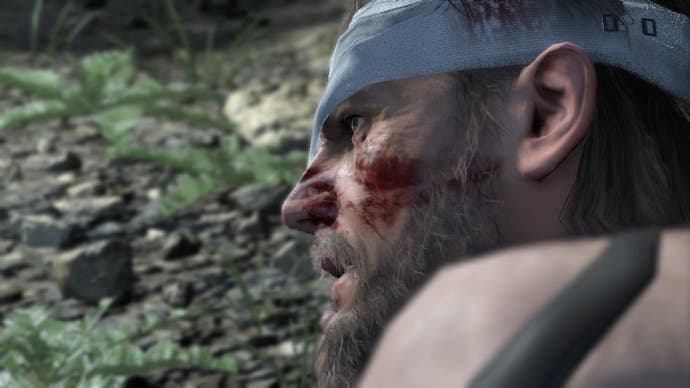
Eurogamer: Jordan, you're making an open-world stealth game. How does that affect traditional stealth design?
Jordan Amaro: There is a fundamental difference between many western games and the way we do things on Metal Gear, and that's partly due to the fact that MGS5 is KJP's first open-world game and we're discovering what that means while making it. There are unknowns and experimentation, and it's scary. In a way that makes us a massive indie boat.
It wasn't a natural transition for me on the design side when I joined KJP. I would start working on missions using my westerner's knowledge. I worked at 2K and Crytek, and I was making missions crafted for the player's enjoyment using what I had learned at Ubisoft, work and had experienced in other games that I like. I was designing with the player as my main preoccupation. All I did was for the player, the player was at the centre of the game. And I was getting it all wrong, this goes against the vision for MGS5.
First, it's not just about the player. The player manipulates a character in third-person that happens to be Snake. So the focus is put on Snake and his actions. You have to imagine, when you build spaces and design the associated mechanics, Snake does not want to get on the enemy's roads. He does not want to intersect their path and risk getting seen. We even dedicate one button to jumping out of sight. So we don't think in terms of: I'm going to make you crawl here, climb there then use that ability on that enemy. That's the outside-in. We think about the interesting situations that can occur in our game through the agency acted by Snake. That's the inside-out.
Second, it's about the world. What makes sense in the environment? What's a realistic village in Afghanistan like?
Once you start thinking like this: I'm going to make you experience Snake being Snake; that's different from: I've placed my gameplay bricks and ingredients and build the environment around it in such a way that as a player you'll feel like it's fun, and you do all those actions that don't reflect anything worthwhile about your character, like western games do too often. It's very different.
Eurogamer: It sounds difficult for the player. Is that accurate?
Jordan Amaro: It's probably going to be more difficult for the players because they're not used to it. Players are going to be in the open world and see this massive base, village or city from afar with a dependency-free objective a kilometre or two away they need to accomplish. 'Now what do I do?' There are big, main roads where enemies are circulating because the context dictates it, and I know if I venture there, probably some patrol is going to get me, so I should be careful.
When you see that location for the first time, from that viewpoint, we have built Snake's routes and the enemy's routes. We don't build them like: I want you the player to get that guy on that rooftop using those means (they're rotated to watch inside their own base in Batman or Assassin's Creed by the way, not outside as it would make sense... plus they walk on rooftops) then do x then y because it's fun. That belongs to you, the player, to do. We've only created a place that our artists have okayed and hopefully makes sense and poses challenges. And that Snake route will be subtle and organic enough so it won't jump to your eyes. We hope to reveal Snake's character through the players' actions in those spaces that are smart to traverse. That's pure game storytelling, although it's still primal because the odds are what they are.
Mike Bithell: So you have a conscious, 'this is where we think Snake will go'?
Jordan Amaro: Yeah.
Mike Bithell: So you're thinking a player might try this or do this?
Jordan Amaro: Yes we cater for that, but primarily it's all made around Snake and that stealth route. Before that, the artists create the open world. They make it look good and make it make sense in terms of topography and the weather. They're the first guys to really get the soul of what Afghanistan is, and we come after that and avoid destroying their work, because they've already got quite close to the truth.
When we come in, we wonder, from this point of view, where the player will come for the first time, what's the route Snake would take? As an experienced agent on the field, where would he go?
Eurogamer: So for you Mike it's obviously very different!
Mike Bithell: Yeah! So I lack the ambition....
That's not available to me. I can't simulate an open world. Unless I go very abstract with it I can't. There are ways into it, and there are open-world indie games, but it's not possible for me. I couldn't do it the way I want to do it. If I were to do an open-world stealth game, I'd want your budget, basically.
"I loved The Last of Us, but I enter the power station and my brother speaks to me, and we go through the power station and I can see all the cover laid out. And I know in typical Naughty Dog fashion, I'm going to bounce through the level. I feel this is passé. This is a bit obsolete."
Jordan Amaro
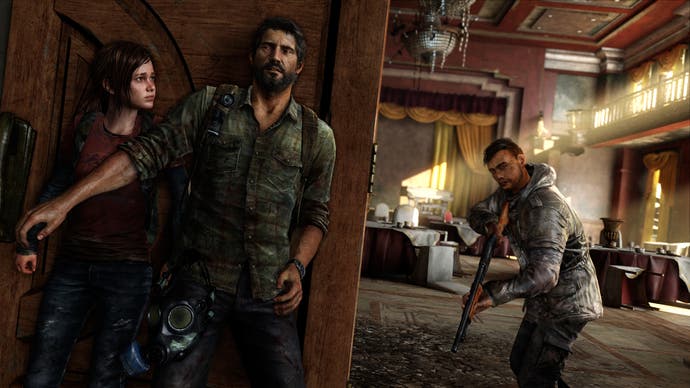
Jordan Amaro: From the games I've played and my work experience I've come to the conclusion that we sacrifice everything for the sake of gameplay and fun. But that's just one component of what makes a game. I really feel bad for environment artists.
I loved The Last of Us, but I enter the power station and my brother speaks to me, and we go through the power station and I can see all the cover laid out. And I know in typical Naughty Dog fashion, I'm going to bounce through the level. I feel this is passé. This is a bit obsolete.
If I had worked on that game I would have pushed to avoid that. I might not have succeeded but I would have reduced the shooting sequence by half and made you progress through another area or loop you in so you get a different viewpoint on an already traversed space. In Uncharted 3 you end up backtracking at almost every mission and I hate that. Obviously it's a bit easy to say that now that the game is out, after all there are circumstances peculiar to any game production that explain the final result and I hope my friends at Naughty Dog don't take it literally.
Mike Bithell: The Last of Us was intentionally old-school in its design. The stealth sections in The Last of Us feel like Metal Gear Solid 1 to me. And that's why I loved them. This is where our tastes differ: I like seeing the cover. Gears of War is obviously the most egregious example. I like walking into an environment in Gears of War and mapping out.
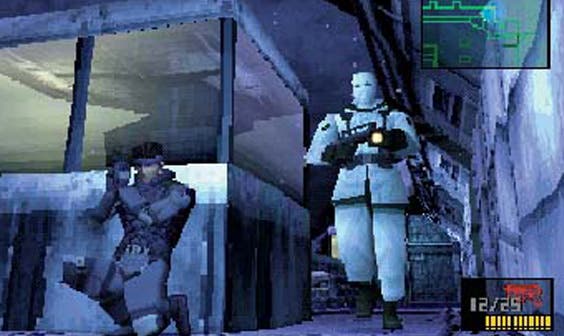
Eurogamer: I'm starting to understand your differing approaches.
Mike Bithell: I'm a massive Metal Gear Solid fan, and this is how I've always felt about Snake (and it's interesting how Kojima played with it in 2): Snake is this hero, he's this on-a-pedestal f***ing awesome guy, and occasionally you let me pretend to be him. It's awesome, but I'm stepping into the shoes of a hero.
Volume is more, 'I want to role-play.' In my game, you are pretending to be the cleverest 22-year-old in England's history. You're a genius. When Snake walks into a room he knows. You're not hiding it from Snake. Snake knows where all that stuff is. It's my job as a player to synchronise - there we go, Assassin's Creed again! - with the reality of who Snake is. And that's how you make that connection. That's my reading of Metal Gear Solid. And that's why Raiden is so interesting. Raiden lets you see Snake through literally another pair of eyes in the game. And the whole playing they do in 2 when Raiden starts spotting Snake and starts to get to know Snake, that's Kojima doing my relationship to Snake as, I'm Raiden, Raiden is the nerdy loser kid. I was 15 when I played that game. He's the nerdy loser kid and he's the impressionable kid who wants to hang out with Snake, but Snake's really f***ing cool! That's what I like about Snake.
That's the difference. It's Brecht and Stanislavski. You're creating Snake by telling me how much dumber than Snake I am, and teaching me to be Snake. Whereas my game, you're already Snake. You're awesome. Which is a different approach.
Eurogamer: Do you agree with that assessment, Jordan?
Jordan Amaro: I understand. And this kind of thinking works perfectly in Batman for example. But for this MGS we believe in exposing the player to situations where he's not in total control and understanding of everything the game has to offer. Snake doesn't know where all the stuff is because... how could he? And we're not going to bend the game and make everything pop up. This time you're on the same level as he is. But it's still an open-world game, right? If you want to go out there and shoot everybody, you're going to feel badass. And you may feel like Snake but in fact you won't be Snake. From our point of view, Snake is not that guy.
We made a game for you so that you can create or be subjected to havoc, and you may feel like him at that moment but everyone knows that's not Snake, right? That's one declination. One version.
Eurogamer: So why do you have that option in the game?
Jordan Amaro: He [Hideo Kojima] wanted to explore what it means to bring the franchise to an open space. He wants to try to bring the player closer to Snake by leaving all these options and reducing the amount of cut-scenes. He wants you to feel close to him, reduce the friction and see what players make of it. And Snake doesn't talk as much. He said, if he talks too much then we have to pay Kiefer Sutherland a lot more!
"I don't remember stealth gamers saying, oh I really wish Garrett could kill people with a machine gun crossbow."
Mike Bithell

Eurogamer: Stealth now is very different to stealth as it was when the first Metal Gear game released. It now seems more action focused. Why has it evolved this way?
Jordan Amaro: Money!
Mike Bithell: I think it is an attempt to broaden a niche past the initial audience. I don't remember stealth gamers wanting the choices. I don't remember stealth gamers saying, 'Oh, I really wish Garrett could kill people with a machine gun crossbow.' I don't remember that being a conversation stealth gamers had.
Metal Gear Solid's Snake can kill with his three-hit combo, and Garrett has his tools for that, and Sam Fisher definitely has guns for that. It's always been there, but I think the balance has declined. I preferred the old way, which was, violence is an escape. Violence is you messing up and dealing with the consequences.
While Metal Gear has kept to that pretty well, with the exception of some parts of 4, it felt like if I was killing people it was because I messed up. That to me is the balance I like.
If that's how you're approaching it, I'm fine with that. Where I have problems is where violence versus stealth is presented as a pure choice. You see this a lot in the marketing campaigns - more so often than in the games themselves. If you look at the way Splinter Cell Blacklist was marketed, the ads on the Tube were like, 'play it your way'. That's where it goes too far for me. At that point that looks a lot like you're trying to get Gears of War players to play your stealth game, and at that point I lose interest because that's not for me any more.
Jordan Amaro: One answer is, it's a legitimate way for any business to broaden their audience to get more money to make more games. Another answer would be, by allowing you to use all this violence in stealth games, we're only expressing what the characters can do in the games. Why would Sam Fisher have to flee all of the time? Why would Garrett have to flee? Have they not been trained or prepared themselves?
It's legitimate. My character is an agent. He has weapons, so why not throw grenades and use RPGs?
Eurogamer: Then why bother with stealth in the first place?
Jordan Amaro: Because it's the essence of an already pre-existing IP.
Mike Bithell: With Metal Gear Solid 4, using the gun wasn't the smoothest option. That's the balancing act for me. Guns should feel like the get out of jail card that puts you in danger. That's where with Splinter Cell I lost track, because the new Splinter Cell, you can literally play it as a third-person shooter and you can get through it a lot quicker. Players do, even if they're not conscious of it, choose the path of least resistance through a game.
I think it is possible to have a gun in a stealth game and not ruin it as a stealth game. It's not the stealth game I chose to make. I chose to go the complete opposite way, but that's something I can do because my game is about a street urchin. My game is about a kid who doesn't understand guns. It doesn't occur to his psyche to use a gun. He's never killed. He doesn't want to.
"If you're making a game that costs tens of millions, you have to justify that budget. I get it."
Mike Bithell
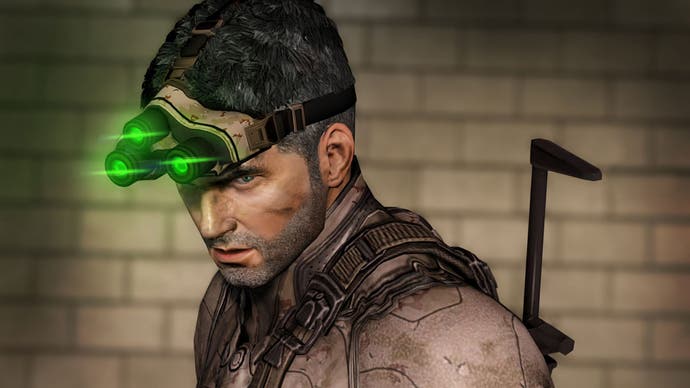
Eurogamer: Jade Raymond told me they were trying to make Splinter Cell more accessible because stealth is too hard for a lot of people. But the word accessibility is such a dirty word among stealth fans.
Mike Bithell: If you're making a game that costs tens of millions, you have to justify that budget. I get it. My argument is stealth was a niche and if people treat it as a niche and admit not everyone is going to play this game, you're not going to turn a stealth game into a Call of Duty.
Volume will not sell many copies. Volume will probably be outsold by Thomas Was Alone, but it's been made in such a way that that's fine. Volume is less approachable than a pretentious indie platformer. I'm just as cynical as Ubisoft, really. I'm trying to capitalise on a niche. I'm saying, I know there are probably a million people in the world who want a stealth stealth game and they want an editor. So the ability to edit levels is as much motivated by, oh, this would be awesome, as, this will get people playing my game and talking about my game and they'll sell it.
Eurogamer: You say stealth was a niche, but I remember Metal Gear Solid being the biggest game in the world at one point.
Mike Bithell: It wasn't because of the stealth. It was like a movie. It was cinematic. It was all these words that used to get bounced around about Metal Gear Solid back before everyone started saying those were the bad things about it.
I think a lot of people who liked Metal Gear liked it despite the stealth. I remember being massively frustrated by the stealth and the reason I got through the stealth bits was because I wanted to see the next cut-scene. Yeah, it was massive, but my point is it was massive as part of a much more niche hobby at the time it came out. It was a big game in a smaller niche.
Jordan Amaro: Accessibility... I don't know what to say about that. It's very sensitive. Help me, what do we mean by accessibility? Do we mean good design? Do we mean changing the values of the game, the core of the game?
Mike Bithell: The end result is more people feel comfortable playing the game.
Jordan Amaro: So that would be good design, right?
Mike Bithell: It would be design that caters to a larger audience. Is that right?
Eurogamer: For many it means dumbing down. It means what they know and love is lessened.
Jordan Amaro: What if I tell you in MGS5, if you don't change the options you have markers and all the stuff you'd expect from a western game, but when you go into the options and you start turning off things, then it becomes more hardcore and more difficult? Would that be a good example of an accessible game that by default is accessible, but if you're an experienced hardcore gamer then you can cater the experience to your liking?
Mike Bithell: There is still the issue of the default game - the definitive Metal Gear Solid 5 experience.
Jordan Amaro: I don't know about you, but when I start a game I go directly into the options to see what's there and tweak the options.
"I'm not giving you some PR BS. In Metal Gear Solid you can customise markers and difficulty. When I turned off everything it was difficult for me as a designer to play the game because if I wasn't careful enough, or if I was sprinting I would be spotted from the tower, and then boom."
Jordan Amaro
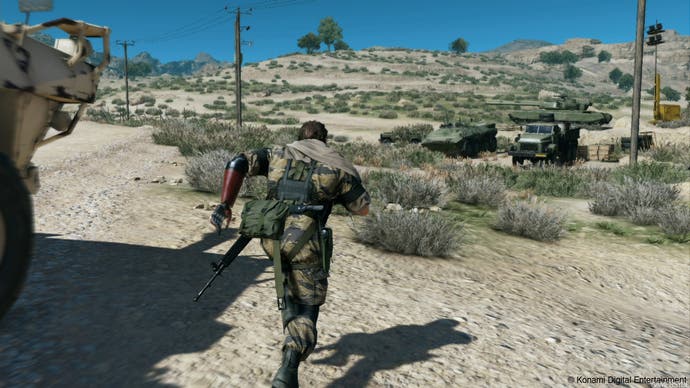
Eurogamer: Doesn't all this impact the design from the ground up?
Jordan Amaro: We've spoken about this at the studio. We made the missions both for people who have time and don't have time, who care and don't care. I spoke about this to Patrick Plourde, the creative director on Far Cry 3, and he said, I also make games for the guy who comes home after a hard day's work, he's tired, he boots up the console, he plays the game and he wants to get it immediately.
Are we going to neglect those people? Are we going to not care about them? I don't think we should. I think the right answer is by default propose them something that is accessible and the hardcore players will explore the options to find their own game.
I'm not giving you some PR BS. In Metal Gear Solid you can customise markers and difficulty. When I turned off everything it was difficult for me as a designer to play the game because if I wasn't careful enough, or if I was sprinting I would be spotted from the tower, and then boom.
So you still have that, but yes you will have to customise the experience.
Mike Bithell: Whatever the default is, that's the version of your game I'll play, because honestly I make the assumption when I start a game that the default is the definitive experience. And that's the experience 99 per cent of your players will have.
I do think there is a very troubling trend in gamer culture that we care too much about what the person sat next to us is experiencing, like how is that affecting my game? Especially in a single-player, focused experience, it's none of my business how someone else plays the game. As a consumer I don't care. If you make it so your game can be turned into the hardest game ever, and I'm playing that version and the guy over there is playing that other version, great, we're both being entertained in exactly the way we want.
The issue gamer culture has right now is in some way the guy having the easier experience devalues the experience of the other person. You see this in all of the discussions - this idea that, if so and so has that thing they want then that affects me. You see if in the debate around sexism and race in games. If that person over there can do the thing I think is wrong, if this game is available that doesn't specifically cater to my tastes, then it affects me. There's an entitlement to that discussion that bothers me. It bothers me that there will be people who complain that, well I shouldn't have to go to the options, it should be by default, it should be the game I want. And I'm kind of with you guys. I think that's fair enough.
I will say, though, I do feel like the default game experience in Metal Gear Solid will be whatever you guys set it to be at the start. There we differ.
Jordan Amano: When I boot Splinter Cell and Deus Ex and Thief 4, I go immediately into the options and then to realistic mode. I don't understand what the fuss is about. I know if I just press A and hey! I'm not going to get the game I'm expecting, so I naturally go into the options to tweak the game.
"In Volume - let's imagine an alternate reality where lockers you can hide in are considered the height of lame-stream game design and there's an option in the options menu to switch off lockers, you can't play Volume any more because my game is really designed."
Mike Bithell
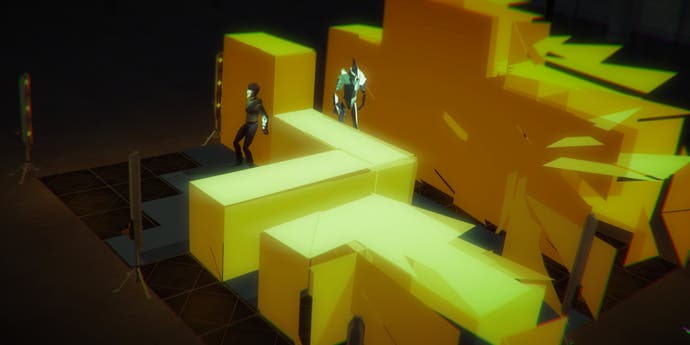
Eurogamer: To counter that, with the last Splinter Cell, even if you put it on its hardest difficulty and turn off things like Mark and Execute, the game still feels different than stealth fans had hoped.
Mike Bithell: It's designed for those things to exist.
Eurogamer: So my question is...
Jordan Amaro: Don't design the game in such a way that it imposes situations or strongly makes you feel like you should be forced to shoot or change your approach or your play style?
Eurogamer: Exactly.
Jordan Amaro: That's the importance of level design, as we talked about. It's the project vision. In an open world we're not bothered by this.
Mike Bithell: Your design approach is less structured than mine. In Volume - let's imagine an alternate reality where lockers you can hide in are considered the height of lame-stream game design and there's an option in the options menu to switch off lockers, you can't play Volume any more because my game is really designed. You can't turn off or on anything. I might not even do a difficulty setting. I probably will! But it will always be a case of, I'm going to make the version of the game I want you to play, and then I'll probably make a slightly easier version if you want it as well.
I'm hemmed in in a way you're not. If you're achieving this objective of, we have an idea for a path, but ultimately we're creating a systems-based game - which is how it sounds - my game is designed. That's a limitation I have to impose upon myself as a designer.
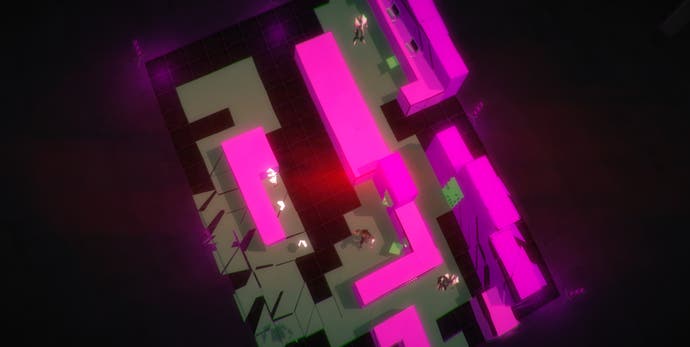
Eurogamer: So what you're saying is because Metal Gear Solid 5 is open-world, you avoid the issues the last Splinter Cell suffered from?
Jordan Amaro: It's systemic. We get rid of all the narrative burdens, like, Sam Fisher or whoever has to go through this emotional state or has to reach that guy. We just go for non-dependent objectives, and we just get rid of all that narrative burden and just focus on what makes the mission good at the core level.
If I go to my lead designer and say, I have this really cool mission where you have to listen to a conversation, you're trailing two guys and have to avoid all these guards that I've carefully placed in the village... that mission would probably be approved in the west provided I've clearly demonstrated and explained what makes it good: patrols, interesting spaces to go through, pacing ect.
But in our studio that wouldn't work, because we don't consider just moving the character - at an input level - an interesting interaction. Just moving the character and staying close enough - and what happens if you're not, do we have to restart the mission? - we don't consider this low level input experience good enough, so we're not going to do this.
But we will do chase quests, for example. You can still stop them through the game systems and you don't have to shoot. You will have to figure out a way to stop their car and then get close enough.
I don't understand why so many people are calling so many games open-world games when they're not. There is usually a fundamental distinction between mission mode and free roam mode. When you play a lot of open-world games, you're actually inside a corridor you're forbidden to leave, or you're set on a course of action you can't derail from. You might be inside a city, but you're inside a corridor inside a city. Is that open-world? I'm not sure.
Mike Bithell is the developer of Thomas Was Alone and Volume. Jordan Amaro is a designer at Kojima Productions working on Metal Gear Solid 5: The Phantom Pain.

